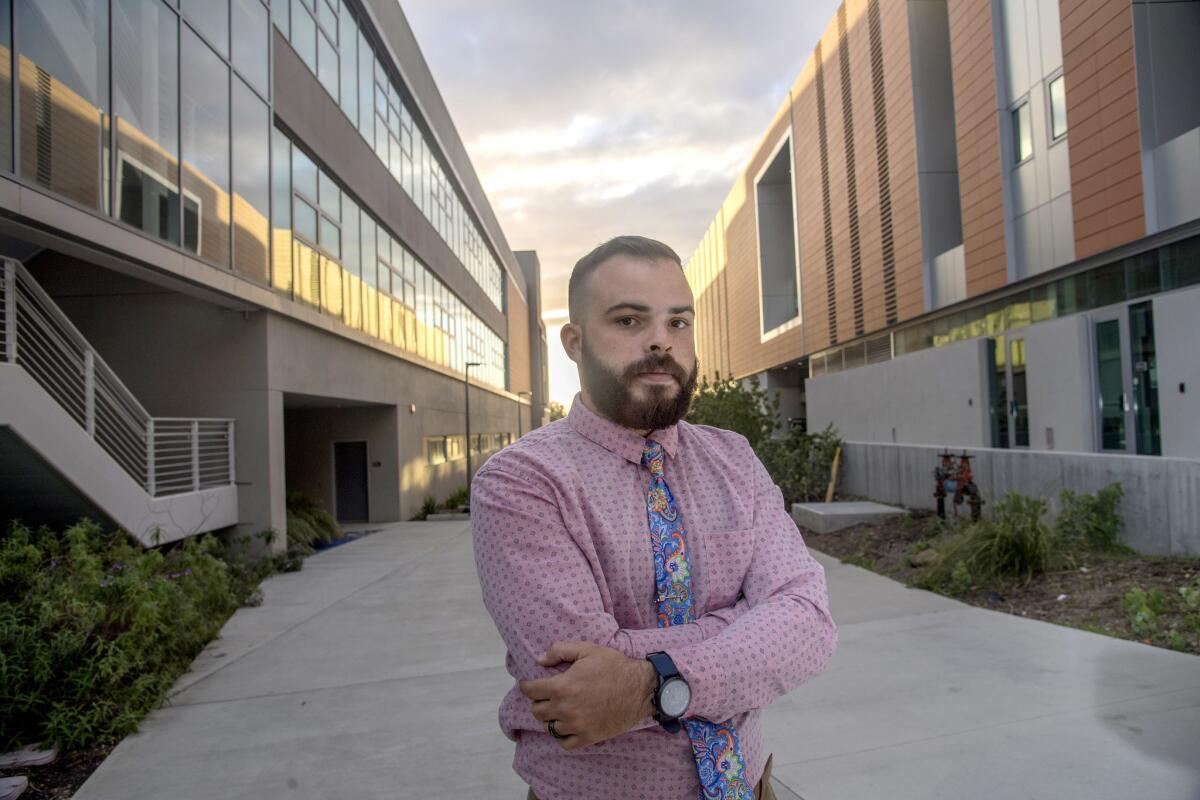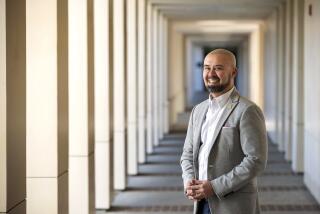Community colleges can cost more than universities, leaving neediest students homeless

Reporting from Sacramento — For Anthony Phillip White II, being in community college while homeless was exhausting, embarrassing — and eventually unrealistic.
Just out of a four-year stint in the Marines, White moved to Oceanside in 2014 to attend MiraCosta College. A single father, he planned to share a home with friends and his then-5-year-old son Trey as he sought to become the first in his family to earn a college degree.
But the house didn’t work out, and his part-time job in a camera store didn’t pay enough for a place of his own. Trey had to stay with his mother in Nebraska, and White moved into his Chevy Silverado, working during the day, taking classes in the evening and searching out safe places to park at night. After eight months in the truck, with help from a veterans group, he got an apartment and got his son back. But trying to parent and pay bills while still making it to class was too hard.
“It just became a lot, trying to go to school, so I stopped going,” he said. “I don’t think paying for classes is the issue. I think it’s the housing, it’s the infrastructure, support. … If we want to lift ourselves up, if we want to produce a better set of leaders for tomorrow, we have to start addressing this.”
Whether living in cars, on couches or outside, homelessness is a persistent problem across California’s 114 community college campuses — a symptom of a larger crisis of affordability for the state’s most vulnerable higher education students.
A study released Thursday by the Hope Center, a research and policy institute, found that 19% of California’s 2.1 million community college students have been homeless during the past year. The survey is the most comprehensive yet done on food and housing insecurity in California community colleges, and included more than 40,000 students across 57 campuses. It echoes earlier findings that 1 in 5 community college students in Los Angeles are without stable shelter.
The study also found that 60% of students in the survey were housing insecure in the past year, with 17% of those eventually falling into the homeless group. Housing insecurity was defined as being in a situation that made losing permanent housing more likely, such as missing a rent payment or having to live in overcrowded situations, said Sara Goldrick-Rab, an author of the study. Homelessness was defined using federal standards specific to students, which includes living situations such as couch surfing, cars or motels, or living outside.
The numbers of homeless students increased for some vulnerable or disadvantaged groups. Thirty-one percent of black students reported being without permanent shelter, while 34% of transgender students and 27% of gay and lesbian students lacked stable homes.
“It’s not about eating Top Ramen and working three jobs,” said Larry Galizio, president of the Community College League of California. “These people are in desperate circumstances.”
In many places in California, the out-of-pocket cost of attending a community college, including housing and other necessities, is out of reach for low-income students — making the effective cost of an education higher than for those who attend state colleges and universities.
Low-income UC San Diego students pay about $9,900 annually out of pocket, according to an earlier report by the Institute for College Access and Success (TICAS). Attending a community college in San Diego, meanwhile, costs about $14,500 a year, similar to Los Angeles but less than in some places. In Sacramento, where year-over-year rent increases have been some of the highest in the country recently, UC Davis costs about $8,000 annually, out of pocket, while community college costs about $19,600. The Sacramento area also had the highest rate of student homelessness, with nearly a quarter reporting they lacked permanent shelter in the past year, the Hope survey found.
“Students are falling short of funds and it’s pretty common for that to happen,” said Goldrick-Rab.
A disparity in financial aid is largely to blame. Grant aid is tied to tuition, with higher tuition leading to more aid that does not have to be repaid. But the greatest expense for students across the state’s higher education system isn’t tuition — it is housing and other living costs. While the total cost of attendance for UC students is 56% higher than for community college students, UC students receive 300% more grant aid, according to TICAS. The average low-income, full-time community college student received $5,800 in state and federal grant aid in the 2017-18 school year. A similar student at a UC school received $27,500, according to TICAS.
Community college students are also less likely to seek and qualify for federal loans, and many community colleges don’t offer them — leaving students to make up the remainder through work, family or other resources.
Spending on free community college for Californians would pay off big for the state »
Terance Williams, 26, spent the fall of 2018 living in his 2002 Pontiac Grand Prix at Laney College in Oakland because he couldn’t get financial aid. Like 43% of homeless students at community colleges, Williams grew up in foster care. On his own at 18, he eventually got a job as a security guard, but was fired after two years when they discovered he didn’t have a high school diploma.
Williams got his GED and enrolled at Laney “the next day,” he said, but couldn’t qualify for financial aid because he had made too much — just over $15 an hour — as a guard. He bounced around living situations before landing in his car, but by November, had decided to drop out.
“I got discouraged,” he said. “It was over.”
A few days later, he was given one of two student housing units on campus — a tiny house built by the campus carpentry department.
“It just changed everything,” Williams said. “It changed the way I thought. It changed the way I felt. … It shouldn’t be this hard to get financial aid.”
Editorial: Why not let homeless college students park in campus lots? »
Goldrick Rab said California has a fundamental problem in how it gives grant aid.
“The bottom line here is California has made a mistake in how it has treated its financial aid resources,” said Goldrick Rab.
Lawmakers have been grappling with the issue for the past few years. Schools in all three of the state’s higher education systems — UC, Cal State and California Community Colleges — are now required to help guide homeless students to food and shelter and to give such students access to campus showers, among other measures.
This year, legislators have introduced multiple proposals to stabilize the experience for community college students and help them pay their bills. Ideas include restructuring how student aid is doled out and a $40-million proposal from Gov. Gavin Newsom to pay for the second year of tuition for full-time community college students at school for the first time.
The most far-reaching proposal would seek to fix the problem Goldrick-Rab sees with financial aid by creating a new grant for community college students — a massive revamping of current practices meant to equalize funding between the three state systems. The proposal, Senate Bill 291 by Sen. Connie Leyva (D-Chino), would give aid to both full- and part-time students based on the cost of living at each campus. It would require $250 million from the state’s general fund in its first year, rising to $1.5 billion by 2024.
“Yes, there is a big price tag attached to this,” said Leyva. “This is our future and our students at community colleges are our future .… Community college, which is supposed to be the most accessible for everyone, is becoming the least accessible.”
The bill is just beginning to wind through the legislative process, but others are pushing measures to address student homelessness in the short term. Assemblyman Marc Berman (D- Palo Alto) introduced a bill that would mandate community colleges consider allowing overnight parking for homeless students.
With lawsuits and overspending, another L.A. Community College bond measure sparks controversy »
White is backing the measure and will tell his story at the state Capitol in coming weeks to support it. He went back to community college in 2017 and soon will transfer to Cal State San Marcos to finish his final year toward a business degree. Last year, he ran for student government and won, introducing a plan for overnight parking on his campus before he learned of the state proposal. He remembers what it was like to hear noises at night in his truck, and being too scared to sleep more than a few hours. He also remembers when, as an adult, he watched his father earn his GED.
“I never thought I was going to go to college,” said White. “But I really want to do something more for my son, and his son .… I am all about legacy.”
More coverage of California politics »
More to Read
Sign up for Essential California
The most important California stories and recommendations in your inbox every morning.
You may occasionally receive promotional content from the Los Angeles Times.










